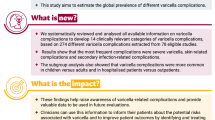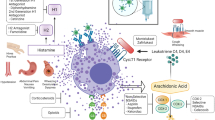Abstract
Background
Pegaspargase (PEG-ASP) is essential chemotherapy for acute lymphoblastic leukemia (ALL). Since changing to intravenous (IV) administration from intramuscular (IM), an increased number of allergic reactions have been anecdotally noted at our institution. This study compares the rate and severity of allergic reactions in children receiving IM or IV PEG-ASP.
Methods
We performed a retrospective chart review of patients treated with IV or IM PEG-ASP at The Hospital for Sick Children, Toronto, Canada, from March 1, 2010 to January 1, 2012. The incidence and severity of allergic reactions attributed to PEG-ASP were documented. Patient age, sex, route of PEG-ASP administration, disease (risk group and lineage) and mean time interval between PEG-ASP doses were evaluated as possible risk factors for allergic reaction.
Results
A total of 109 patients were included. There were 14 (35 %) allergic reactions among 40 patients who received IV, compared with eight (12 %) of the 69 who received IM [odds ratio (OR) 4.11, 95 % confidence interval (CI) 1.54–10.97, p = 0.005]. In multivariable logistic regression adjusting for disease risk group, route (IV vs. IM) remained independently significant (p = 0.011). Patients with standard-risk ALL had a lower risk of experiencing an allergic reaction associated with PEG-ASP compared with patients in high-risk disease risk groups (collectively referred to as “other”; 11 vs. 31 %, OR 3.36, 95 % CI 1.16–9.72, p = 0.025).
Conclusions
IV PEG-ASP is associated with a significantly higher rate of allergic reactions than IM. The clinical preference for IV PEG-ASP may warrant re-evaluation.

Similar content being viewed by others
References
Silverman LB, et al. Results of Dana-Farber Cancer Institute Consortium protocols for children with newly diagnosed acute lymphoblastic leukemia (1981–1995). Leukemia. 2000;14(12):2247–56.
Silverman LB, et al. Improved outcome for children with acute lymphoblastic leukemia: results of Dana-Farber Consortium Protocol 91-01. Blood. 2001;97(5):1211–8.
Rytting M. Peg-asparaginase for acute lymphoblastic leukemia. Expert Opin Biol Ther. 2010;10(5):833–9.
Haley EE, Fischer GA, Welch AD. The requirement for l-asparagine of mouse leukemia cells L5178Y in culture. Cancer Res. 1961;21:532–6.
Pidaparti M, Bostrom B. Comparison of allergic reactions to pegasparaginase given intravenously versus intramuscularly. Pediatric Blood Cancer. 2012;59(3):436–9.
Kurtzberg J, et al. Polyethylene glycol-conjugated l-asparaginase versus native l-asparaginase in combination with standard agents for children with acute lymphoblastic leukemia in second bone marrow relapse: a Children’s Oncology Group Study (POG 8866). J Pediatr Hematol Oncol. 2011;33(8):610–6.
Avramis VI, et al. A randomized comparison of native Escherichia coli asparaginase and polyethylene glycol conjugated asparaginase for treatment of children with newly diagnosed standard-risk acute lymphoblastic leukemia: a Children’s Cancer Group study.[Erratum appears in Blood 2002 Sep 1;100(5):1531]. Blood. 2002;99(6):1986–94.
Nesbit M, et al. Evaluation of intramuscular versus intravenous administration of l-asparaginase in childhood leukemia. Am J Pediatr Hematol Oncol. 1979;1(1):9–13.
Silverman LB, et al. Intravenous PEG-asparaginase during remission induction in children and adolescents with newly diagnosed acute lymphoblastic leukemia. Blood. 2010;115(7):1351–3.
Douer D, et al. Pharmacodynamics and safety of intravenous pegaspargase during remission induction in adults aged 55 years or younger with newly diagnosed acute lymphoblastic leukemia. Blood. 2007;109(7):2744–50.
Cancer Therapy Evaluation Program, Common Terminology Criteria for Adverse Events (CTCAE) version 4.0. Cancer National Institute, May 28, 2009 (V4.03: June 14, 2010).
Petersen WC Jr, et al. Comparison of allergic reactions to intravenous and intramuscular pegaspargase in children with acute lymphoblastic leukemia. Pediatr Hematol Oncol. 2014;31(4):311–7.
August KJ, et al. Comparison of hypersensitivity reactions to PEG-asparaginase in children after intravenous and intramuscular administration. J Pediatr Hematol Oncol. 2013;35(7):e283–6.
MacDonald T, et al. Significantly higher incidence of allergic reactions for intravenous peg-asparaginase as compared to intramuscular peg-asparaginase in children with high risk acute lymphoblastic leukemia. Pediatr Blood Cancer. 2014;61(S2):171.
Thong BY, Tan TC. Epidemiology and risk factors for drug allergy. Br J Clin Pharmacol. 2011;71(5):684–700.
Fernandez CA, et al. HLA-DRB1*07:01 is associated with a higher risk of asparaginase allergies. Blood. 2014;124(8):1266–76.
Armstrong JK, et al. Antibody against poly(ethylene glycol) adversely affects PEG-asparaginase therapy in acute lymphoblastic leukemia patients. Cancer. 2011;110(1):103–11.
Guilleminault L, et al. Positive skin test to pegylated drug in a patient with anaphylaxis to polyethylene glycol. Rev Fr Allergol. 2012;52(1):45–7.
Casadevall N. Pure red cell aplasia and anti-erythropoietin antibodies in patients treated with epoetin. Nephrol Dial Transplant. 2003;18 Suppl 8:837–41.
van den Berg H. Asparaginase revisited. Leuk Lymphoma. 2011;52(2):168–78.
Graham ML. Pegaspargase: a review of clinical studies. Adv Drug Deliv Rev. 2003;55(10):1293–302.
Panosyan EH, et al. Asparaginase antibody and asparaginase activity in children with higher-risk acute lymphoblastic leukemia: Children’s Cancer Group Study CCG-1961. J Pediatr Hematol Oncol. 2004;26(4):217–26.
Rizzari C, et al. l-asparagine depletion and l-asparaginase activity in children with acute lymphoblastic leukemia receiving i.m. or i.v. Erwinia C. or E. coli l-asparaginase as first exposure. Ann Oncol. 2000;11(2):189–93.
Strullu M, et al. Silent hypersensitivity to Escherichia coli asparaginase in children with acute lymphoblastic leukemia. Leuk Lymphoma. 2010;51(8):1464–72.
Acknowledgments
The authors acknowledge the contributions of Elizabeth Uleryk, BA, MLS, library scientist at The Hospital for Sick Children.
Funding
No sources of funding were used in the performance of this study or in the preparation of this manuscript.
Conflict of interest
L. S. Abbott, M. Zakova, F. Shaikh, N. Shewaramani, A. Punnett and L. L. Dupuis have no conflicts of interest to declare.
Author information
Authors and Affiliations
Corresponding author
Additional information
L. S. Abbott and M. Zakova contributed equally to this work.
Electronic supplementary material
Below is the link to the electronic supplementary material.
Rights and permissions
About this article
Cite this article
Abbott, L.S., Zakova, M., Shaikh, F. et al. Allergic Reactions Associated with Intravenous Versus Intramuscular Pegaspargase: A Retrospective Chart Review. Pediatr Drugs 17, 315–321 (2015). https://doi.org/10.1007/s40272-015-0129-1
Published:
Issue Date:
DOI: https://doi.org/10.1007/s40272-015-0129-1




